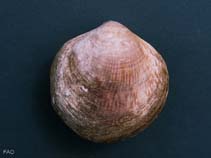Glycymeris pilosa (Linnaeus, 1767)
Pilose bittersweetWarning: DOMDocument::load(): SSL operation failed with code 1. OpenSSL Error messages: error:140770FC:SSL routines:SSL23_GET_SERVER_HELLO:unknown protocol in C:\Apache24\htdocs\includes\SpeciesSummary.lib.php on line 1236
Warning: DOMDocument::load(): Failed to enable crypto in C:\Apache24\htdocs\includes\SpeciesSummary.lib.php on line 1236
Warning: DOMDocument::load(https://sealifebase.nrm.se/webservice/AquaMaps/getAMap.php?genus=Glycymeris&species=pilosa): failed to open stream: operation failed in C:\Apache24\htdocs\includes\SpeciesSummary.lib.php on line 1236
Warning: DOMDocument::load(): I/O warning : failed to load external entity "https://sealifebase.nrm.se/webservice/AquaMaps/getAMap.php?genus=Glycymeris&species=pilosa" in C:\Apache24\htdocs\includes\SpeciesSummary.lib.php on line 1236
Classification / Names Common names | Synonyms | CoL | ITIS | WoRMS
| Arcida | Glycymerididae
Environment: milieu / climate zone / depth range / distribution range Ecologia
; intervalo de profundidade 60 - 200 m (Ref. 2754). Subtropical; 45°N - 27°N, 14°W - 37°E (Ref. 104468)
Distribuição Países | Áreas FAO | Ecossistemas | Ocorrências | Introduções
The Mediterranean and the Sea of Marmara: Throughout the Mediterranean and Atlantic coasts of Morocco and Portugal.
Length at first maturity / Tamanho / Peso / Idade
Maturity: Lm ? range ? - ? cm
Minimum depth from Ref. 104203. Littoral (Ref. 2754). Found on coralligenous habitats (Ref. 105982). In general, suspension feeding bivalves mainly depend on phytoplankton and detritus material for nutrition (Ref. 107088).
Life cycle and mating behavior Maturidade | Reprodução | Desova | Ovos | Fecundidade | Larvas
Members of the class Bivalvia are mostly gonochoric, some are protandric hermaphrodites. Life cycle: Embryos develop into free-swimming trocophore larvae, succeeded by the bivalve veliger, resembling a miniature clam.
Referência principal
Referências | Coordenador | Colaboradores
Demir, M. 2003. (Ref. 2754)
Categoria na Lista Vermelha da IUCN (Ref. 130435)
Categoria CITES (Ref. 108899)
Not Evaluated
CMS (Ref. 116361)
Not Evaluated
Ameaça para o homem
Utilização humana
| FishSource |
Ferramentas
Mais informação
Fontes da internet
BHL | BOLD Systems | CISTI | DiscoverLife | FAO(Publication : search) | Fishipedia | GenBank (genoma, nucleotídeo) | GloBI | Gomexsi | Google Books | Google Scholar | Google | PubMed | Árvore da vida | Wikipedia (ir para, procurar) | Registo zoológico
Estimates based on models
Preferred temperature
(Ref. 115969): 13.3 - 16.6, mean 14.7 (based on 53 cells).
Categoria de preço
(Ref. 80766):
Unknown.



